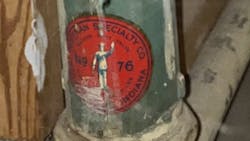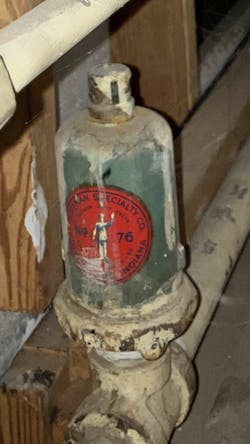A Hard-to-Find Air Vent in a Steam System Evaluation
I never knew that there was a Christmas version of an automatic air vent for a residential steam heating system. When I finally found it, I instantly knew this story would be for the holiday issue. Just look at that deep pine green and vivid red color scheme. It screams Santa will soon be coming down the chimney.
This was one of my first site visits I made after the hernia operation. One of my favorite contractors asked me to meet at a house on the west side of town in a neighborhood of well-kept modest houses built in the 1920s. My wife and I looked at a house on this street 40 years ago when we were looking for a Tudor-style residence.
I was there to help evaluate the system and give advice to the homeowner. When we walked in through the garage, I noticed supply and return pipes exposed in the ceiling. The boiler room was a short walk through a finished basement where there wasn’t a pipe in sight.
Trouble on the Return Side
The boiler was piped as expected on the supply side, no reason to change any of that. The return side, however, looked odd. There was one pipe coming out of the bottom of the boiler room wall, literally on the floor. It then rose up to join the equalizer to create the Hartford Loop. That’s how it’s done, but the return piping was missing a few things.
We walked back out of the boiler room and found a built-in bookcase right over the pipe, running along the outside wall between the boiler room and the garage. Okay, the missing parts must be in the garage since I’ve seen systems with the end of steam and return mains exposed in the garage.
Exploring the garage, I found no evidence of the end of the mains, just the exposed pipes running through the garage in the ceiling. When I run into a dead end, I start back at the beginning. In this case, it would be the supply lines leaving the boiler room. Before starting that journey, the nice lady that has lived in the house for the last 50 years or so joined us.
She reported that the house has heated fine for years and that her recently departed husband knew all about the steam system. Also, he did all the remodeling to finish the basement. I’m sure he was a fine man, but I was cursing his carpentry that covered every square inch of wall and ceiling outside the boiler room.
Tracking the Mains
The steam supply main off the boiler header split into two mains, very typical for a system this size. I tracked the first main out of the boiler room, across the ceiling to the garage, where it took a right-hand turn, re-entered the remodeled space and disappeared. I retreated to track the other main.
The ceiling of the basement was a combination of drop-in tiles and finished drywall. It became evident that the finished drywall covered the path of the two mains. This one went to the center beam of the house and took a left turn. We found a few access panels in the finished drywall covering the center beam. Looking through them, I saw the two steam mains and the two dry returns.
Just as we’re making some progress, I started to feel a little puny. I asked the nice lady if I could sit down and have a glass of water. The chair I picked was just outside the boiler room, looking out at the portion of the finished ceiling where we last caught sight of the mains. They were concerned about my health, while I was trying to use my x-ray vision to see through the drywall.
I directed the contractor to remove some ceiling tiles near where I now suspected we would find the next clue. The nice lady didn’t quite understand what we were looking for or why it was important, but was willing to let us look. When I got my strength back, I climbed up a small ladder below where the ceiling tiles were removed.
Watchman of the Coal Pile
What you can’t make out is the slogan below the man in uniform. It reads, “Watchman of the coal pile.” That dates the vents to the coal-burning boiler era. Another clue is the part number, “No. 76.” This vent was for a naturally inducing a vacuum in a coal-fired steam system.
It had a built-in check valve that allowed air out, but closed to prevent air from re-entering the piping as the coal fire in the belly of the boiler lost temperature. The check valve allowed the system to go into a vacuum, which kept the boiler making steam at lower than 213ºF degree boiler water temperatures. That would lead to less coal being burned, or so the manufacturer claimed.
New Vents, Better Access
The general wisdom of the industry is to replace any vacuum vents on automatic-fired steam boilers with standard vents, allowing air back into the piping in the off cycle to allow condensate to freely flow back to the boiler. I recommended replacing the vents and making an access panel in the drywall so future generations can service the system.
So, the end of steam mains and dry returns were separated from the boiler room by the remodeling. The wet return that they tied into was buried behind a wall and under a bookcase before appearing in the boiler room.
On the medical front, I’m recovered from the hernia and awaiting surgery for the removal of lymph nodes and part of my large intestine, per the advice of my oncologist and the collective wisdom of the cancer community. Thanks for letting me share my journey, it seems to help to write it down.
Patrick Linhardt is a forty-year veteran of the wholesale side of the hydronic industry who has been designing and troubleshooting steam and hot water heating systems, pumps and controls on an almost daily basis. An educator and author, he is currently Hydronic Manager at the Corken Steel Products Co.
About the Author
Patrick Linhardt
Patrick Linhardt is a forty-one-year veteran of the wholesale side of the hydronic industry who has been designing and troubleshooting steam and hot water heating systems, pumps and controls on an almost daily basis. An educator and author, he is currently Hydronic Manager at the Corken Steel Products Co.

